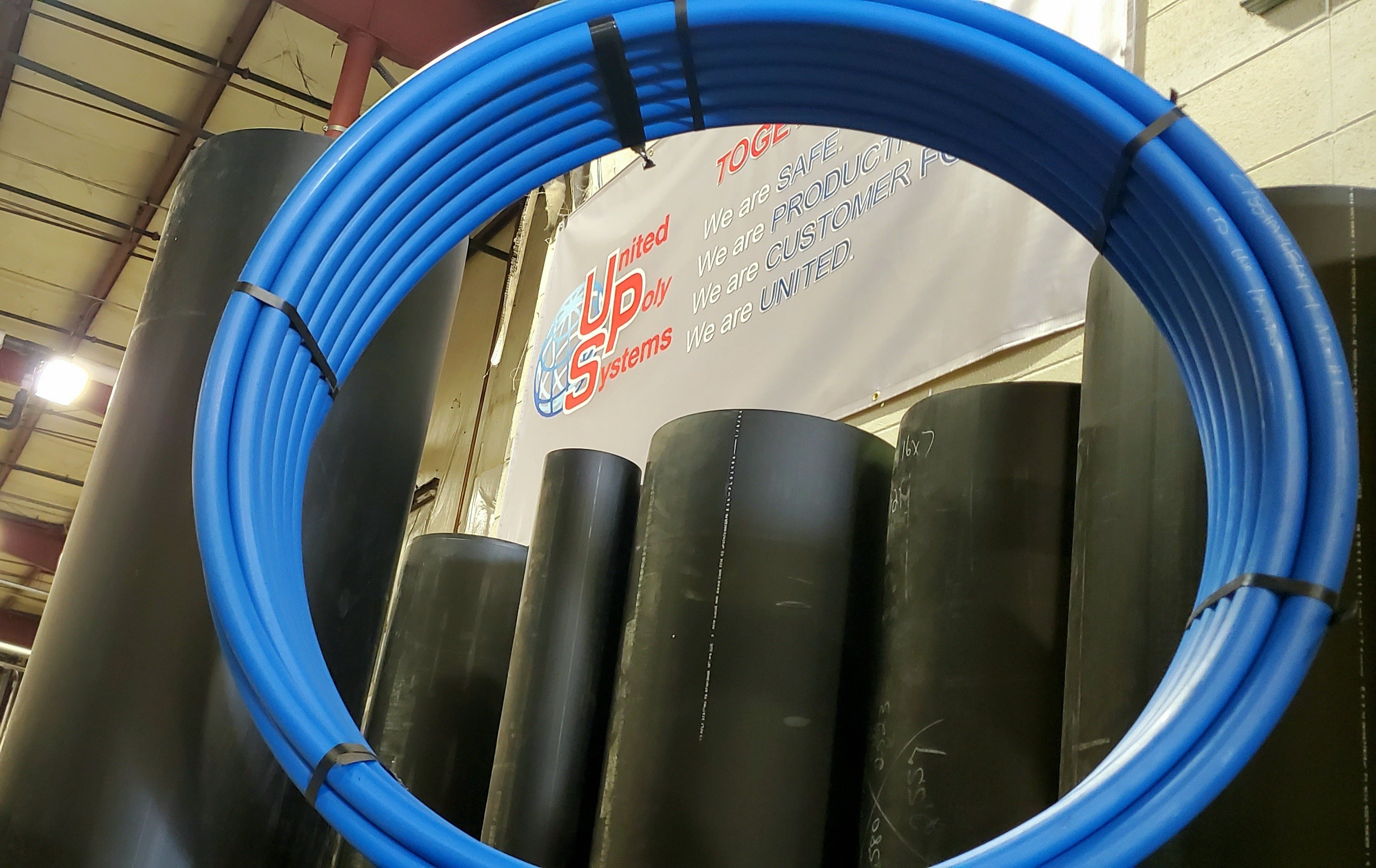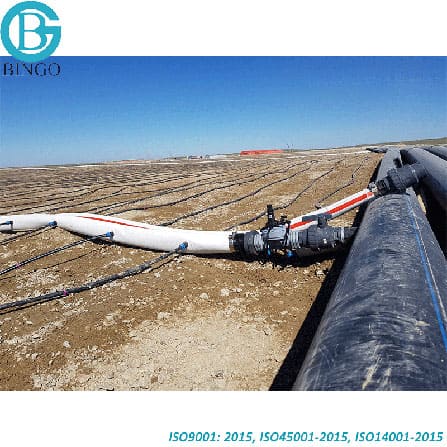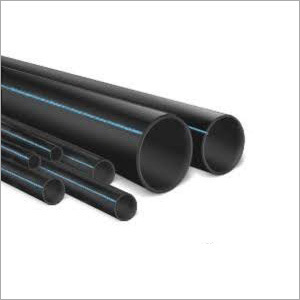Strengths of Choosing custom hdpe pipe manufacturing Midland TX for Unique Requirements
Wiki Article
Discover the Production Process Behind High-Quality HDPE Pipe and Its Applications
The production process of premium HDPE pipelines is intricate and systematic. It begins with the selection of resources that enhance efficiency. Following this, ethylene goes through polymerization to create resin, which is after that formed through extrusion. Quality control is critical, making certain that the end product fulfills rigid requirements. However, the journey of HDPE pipelines doesn't end with manufacturing. Their applications across numerous industries disclose a wider relevance worth checking out.Understanding HDPE: Residences and Advantages

High-density polyethylene (HDPE) is a flexible thermoplastic understood for its sturdiness and resistance to numerous ecological factors. This material exhibits superb tensile strength, making it suitable for demanding applications. Its low-density framework adds to a light-weight product, promoting ease of dealing with and setup. HDPE likewise showcases amazing resistance to chemicals, which reduces deterioration when subjected to rough compounds.
The product's low wetness absorption even more enhances its durability, making it ideal for usage in pipes and tank. Furthermore, HDPE is resistant to ultraviolet (UV) radiation, guaranteeing that products keep their integrity even when revealed to sunshine. Its adaptability allows for the development of intricate shapes without endangering toughness. The green nature of HDPE, typically originated from recycled materials, adds to its charm, advertising lasting methods in production. In general, these buildings and benefits make HDPE a recommended selection for various industrial and consumer applications.
Basic Material Option for HDPE Manufacturing
The option of raw materials for HDPE production is vital to verify the last item satisfies the wanted specs and quality requirements. High-density polyethylene (HDPE) is largely produced from polymerized ethylene, stemmed from fossil fuels such as gas or petroleum. The top quality of these feedstocks considerably affects the mechanical and thermal buildings of the last HDPE.Additives also play a considerable function in boosting HDPE's performance, consisting of anti-oxidants, UV stabilizers, and colorants, which improve toughness and resistance to ecological aspects. The choice process have to take into consideration not just the chemical composition of the raw products however also their processing features to assure reliable production.
The sourcing of raw materials should prioritize sustainability and conformity with environmental guidelines, as liable techniques are imperative in today's market. Eventually, careful raw product selection lays the foundation for generating high-quality HDPE pipes suitable for varied applications.
The Extrusion Process: Shaping HDPE Pipe
The extrusion procedure plays an essential function in forming HDPE pipelines, starting with precise material prep work techniques that ensure excellent flow and consistency. Equally vital is the design of the die, which straight influences the last measurements and surface area top quality of the pipe. With each other, these aspects contribute considerably to the performance and top quality of HDPE pipeline manufacturing.Product Prep Work Strategies
Efficient manufacturing of HDPE pipelines starts with thorough product preparation techniques, specifically the extrusion process. Throughout this stage, high-density polyethylene material is initial dried out to eliminate wetness, ensuring excellent flow attributes. The resin is then fed into the extruder, where it goes through home heating and melting, changing into a viscous state. This home heating process is meticulously regulated to keep the material's honesty and performance. The molten HDPE is required with a die, shaping it right into a continual pipe form. Proper temperature monitoring during extrusion is necessary, as it straight affects the material's properties and the last product high quality. When formed, the HDPE install gas line for stove pipeline is cooled down and cut to defined lengths, all set for subsequent handling and applications.Die Design Significance
Accuracy in die style plays a crucial role in the extrusion process of HDPE pipes. The die serves as the last shaping tool, straight affecting the pipe's dimensions, wall surface density, and surface area coating. A properly designed die warranties consistent product flow, reducing problems such as abnormalities and weak points. The geometry of the die must be enhanced to suit the certain residential properties of HDPE, including its thickness and thermal behavior during extrusion. In addition, the cooling rate of the material as it travels through the die can noticeably affect the pipeline's architectural stability. Spending in innovative die innovation is essential for producers intending to create premium HDPE pipelines that meet sector requirements and consumer expectations.Quality Assurance Measures in HDPE Manufacturing
Although different aspects influence the top quality of HDPE pipe manufacturing, reliable quality assurance steps are crucial to ensure consistency and integrity in the end product. Key quality assurance practices include rigorous product examination, confirming that the raw polyethylene satisfies well established requirements for purity and density. During the extrusion procedure, parameters such as temperature level, stress, and cooling time are very closely checked to maintain dimensional accuracy and structural stabilityFurthermore, post-production testing is crucial; producers usually carry out hydrostatic examinations to analyze the pipeline's strength and resistance to stress. Aesthetic assessments for surface area issues better boost high quality assurance. Accreditation from relevant requirements companies, like ASTM or ISO, offers an additional layer of reputation. By implementing these complete quality assurance procedures, makers can lessen defects, boost performance, and make certain that the HDPE pipelines meet the certain needs of various applications, ultimately resulting in consumer satisfaction and count on the product.
Applications of HDPE Pipe Across Industries
HDPE pipelines are made use of throughout various fields as a result of their toughness and adaptability. In water circulation systems, they assure effective shipment, while in wastewater management, they supply reliable options for waste transportation. Additionally, farming watering networks gain from HDPE's resistance to deterioration and adaptability, making it a perfect selection for modern-day farming techniques.
Water Distribution Equipments
A significant number of markets depend on high-density polyethylene (HDPE) pipes for efficient water circulation systems. Understood for their durability and resistance to deterioration, HDPE pipelines are extensively utilized in community water system networks, farming irrigation, and industrial applications. Their lightweight nature assists in very easy handling and setup, reducing labor costs and time. Furthermore, HDPE pipes can fit numerous pressure levels, making them appropriate for both low and high-pressure systems. custom hdpe pipe manufacturing Midland TX. The versatility of the product enables seamless combination right into existing infrastructure, minimizing the demand for comprehensive excavation. HDPE's resistance to chemical seeping warranties that the water delivered remains safe and tidy, making it a suitable option for preserving the high quality of drinkable water throughout different fields.Wastewater Administration Solutions
Effective water distribution systems likewise lead the way for ingenious wastewater management services, where high-density polyethylene (HDPE) pipes play a considerable role. Popular for their resilience and resistance to corrosion, HDPE pipelines are suitable for moving wastewater in numerous setups. Their adaptability enables for simple setup in intricate atmospheres, reducing the demand for extensive excavation. Additionally, HDPE's smooth interior surface minimizes friction, improving circulation prices and performance. These pipes are likewise immune to chemical leaching, making certain that pollutants do not compromise the surrounding setting. Industries, communities, and why not try here therapy facilities progressively count on HDPE pipes for their reliability and durability, making them a preferred option for modern wastewater administration systems. This versatility underscores the important value of home HDPE pipes across numerous applications.Agricultural Watering Networks
Agricultural watering networks benefit substantially from making use of high-density polyethylene (HDPE) pipes, which provide efficient and reliable water delivery to crops. HDPE pipes are lightweight, making them very easy to transport and mount, while their adaptability enables various setups in varied surfaces. These pipelines show exceptional resistance to corrosion, chemicals, and UV radiation, ensuring sturdiness in severe farming settings. Furthermore, their smooth indoor surface area decreases rubbing loss, maximizing water flow and decreasing power costs related to pumping. The long life of HDPE pipes, commonly going beyond 50 years, adds to lower upkeep and substitute expenses. Farmers significantly rely on HDPE pipes to improve watering performance and advertise sustainable agricultural methods, inevitably leading to enhanced crop returns and source conservation.
Future Trends in HDPE Pipe Modern Technology
As the demand for sustainable and reliable infrastructure grows, developments in HDPE pipe modern technology are positioned to change numerous industries. Emerging patterns include the assimilation of smart modern technologies, such as sensors and IoT capabilities, which assist in real-time surveillance of pipe problems, minimizing upkeep expenses and stopping leakages. Additionally, the advancement of sophisticated production techniques, such as 3D printing, is allowing the production of facility, personalized pipe layouts that deal with details project requirements.Additionally, the concentrate on recycling and round economic climate techniques is driving the innovation of HDPE pipes made from recycled materials, boosting sustainability. Enhanced jointing methods, such as electro-fusion and mechanical fittings, are additionally improving installation efficiency and reliability. Lastly, the expanding emphasis on environmental regulations is pressing manufacturers to adopt greener production processes, guaranteeing that HDPE pipelines not just meet industry requirements yet additionally promote a more sustainable future for framework advancement.
Frequently Asked Inquiries
Exactly How Does HDPE Compare to Various Other Plastic Products?
HDPE exceeds numerous various other plastic materials pertaining to toughness, chemical resistance, and flexibility. Its reduced thickness and high tensile toughness make it suitable for different applications, frequently surpassing alternatives in both efficiency and long life.What Are the Ecological Influences of HDPE Manufacturing?
The ecological effects of HDPE manufacturing consist of greenhouse gas discharges, energy consumption, and prospective air pollution from making processes. In addition, incorrect disposal can cause dirt and water contamination, raising problems regarding lasting eco-friendly effects.Can HDPE Piping Be Recycled?
Yes, HDPE pipelines can be reused. Several centers accept used HDPE for handling, changing it right into brand-new items. This recycling adds to sustainability initiatives, decreasing plastic waste while preserving resources and energy in the manufacturing cycle.What Is the Life-span of HDPE Water Lines?

How Do Temperature Variations Affect HDPE Pipe Performance?
Temperature variants considerably influence HDPE pipeline efficiency, affecting adaptability and strength. High temperatures can result in softening, while reduced temperature levels may create brittleness, inevitably affecting the pipe's longevity and suitability for different applications in diverse atmospheres.Report this wiki page